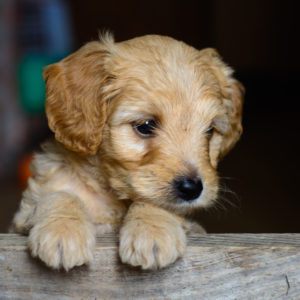Doodles, Habibi Bears, and More: The Genetics of Novel Dog Crosses
August 28, 2020 - 5 minutes readDogs are one of the most diverse groups of animals in the world. Visit any dog park and you’ll see variation in nearly every single characteristic. Floppy ears and pointy ears. Long legs and short ones. Streamlined bodies and ones built for snuggling. The genetic variation in dogs is remarkable!
Through the ages, humans have selectively bred dogs for various characteristics. By carefully considering which animals to breed, we’ve culled through the genetic diversity of dogs as a whole and created lines of dogs who breed true. This means that puppies from these lines will display a predictable and distinct set of physical and behavioral attributes.
These purebred dogs meet accepted breed standards with specific characteristics such as a poodle’s curly coat or a German Shepherd’s long muzzle. Often specific breeds have a knack for a particular skill or job such as herding, retrieving, or hunting. There are hundreds of recognized dog breeds from large, lovable, droopy-faced St. Bernards to rambunctious and tenacious Jack Russell Terriers.
In recent years we’ve seen a boom in novel dog crosses that result in dogs with desirable features. The most common of these are the doodles—labradoodles, golden doodles, bernadoodles, sheepadoodles, and more. The whole doodle trend got started from a desire to blend the non-shedding characteristics of poodles with the demeanor of labradors or retrievers.
A common misconception is that these dogs represent new purebred lineages, but you won’t find the various doodles on the American Kennel Club breed list (which we also use on the Health and Life Experience Survey) because doodles are often what we call hybrids. Rather than being the offspring of two purebred dogs of the same breed, hybrids are the offspring from two different purebred dog parents. In genetic terms, the first generation of puppies produced from a hybrid cross is sometimes referred to as F1 hybrids. The F in F1 stands for filial, meaning related to offspring and the 1 denotes the first generation.
Unlike purebred dogs, F1 hybrids do not breed true. Instead, puppies from hybrid crosses tend to display a much wider spectrum in the appearance and behavior. Not only can they look and act very differently from their parents, puppies in the same litter can be quite different from one another. The image below illustrates how this works.
The parental generation consists of a labrador and a poodle. The four puppies in the F1 generation each inherit a different combination of labrador genes and poodle genes. If two doodles were crossed, the next generation (often called the F2 generation) could show an even wider range of physical and behavioral characteristics (also called phenotypes) with some of the puppies being very similar to their labrador parent while others resemble their poodle parent.
Because many doodle breeders are hoping to achieve the non-shedding characteristics from the poodle genome, some will plan what are called backcrosses. This means that an F1 or F2 doodle might be bred (or backcrossed) to another purebred poodle. This would result in puppies (called F1b or F2b) that have a higher proportion of poodle genes and poodle coat characteristics. With time and carefully planned breeding schemes, novel crosses could become true breeding lines and therefore be considered purebreds. After all, the purebreds that we currently know and love began as novel crosses long ago.
Studying genetic variation in purebred, mixed breed, and hybrid dogs is a key focus of our project. We’ll be sequencing the genomes of 10,000 dogs and comparing their sequence data to health measures in order to identify the genetic components of healthy aging and longevity in dogs.
A critical part of our research design is studying ALL kinds of dogs from ALL kinds of environments and with ALL kinds of genetic backgrounds so bring us your doodles, your puggles, your cavipoos, and your habibi bears!
We love them ALL!
